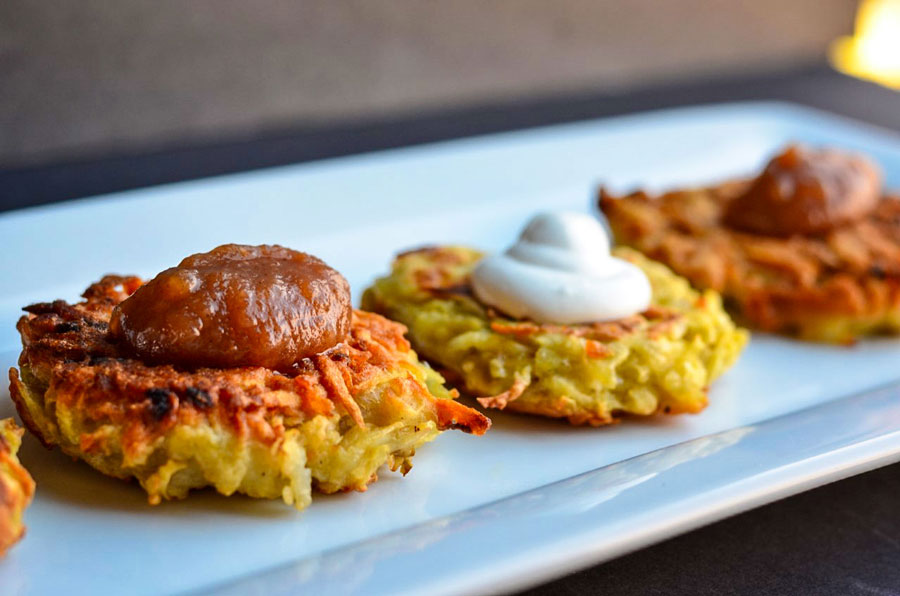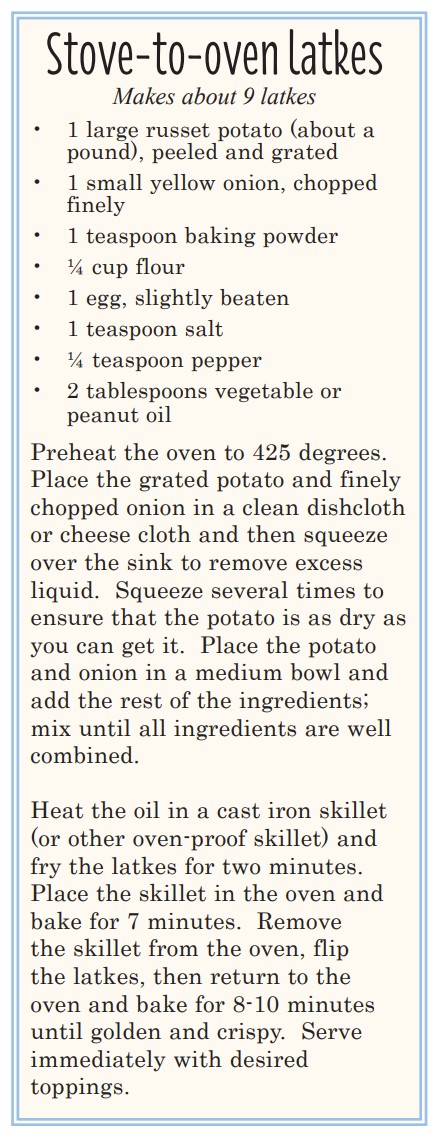Latkes Light Up the Holiday

Hanukkah begins on December 18 this year, just a few days before the shortest day on the calendar – a joyful celebration of light during dark times. I don’t celebrate Hanukkah, but as a kid I spent quite a bit of time with friends who did, playing dreidel games to win chocolate coins and lighting candles.
I thought all the Hanukkah traditions were fun, but I was especially taken with the food – deep fried delicacies served with sugary coatings or decadent toppings. As a 10-year-old, I was no stranger to the joy of a warm doughnut on a cold evening, but the first time I ever ate a latke was at a Hanukkah party.
All that deep fried food is more than delicious. The oil symbolizes the oil used in a menorah after a victory in battle. While there was only enough oil to keep the light burning for one night, the oil miraculously lasted for eight days, an event now celebrated during Hanukkah. Traditional doughnuts are called sufganiyot – fried, filled with jam or jelly, and dusted with powdered sugar. Simple and delicious. In my memory, though, the latkes were the star of the show.
Before I did any tasting, the idea of a latke seemed a bit foreign (which of course it actually was). A pancake made from potatoes and served without syrup was a paradigm shift from elementary-school me; but I never passed up an opportunity to eat something new, so I grabbed a fork and set to work building my evening’s feast.
Following the lead of my Jewish friend, I slathered on a generous dollop of cold sour cream that softened and ran just a bit on the warm latke. I then added a spoonful of chunky applesauce. In my life (a whole decade’s worth at this point), the thought of eating sour cream and applesauce together had never occurred to me. I could hardly believe that it would be tasty, but I took a generous forkful and was pleasantly surprised to find that not only could I tolerate this unusual combination of foods, I actually loved it. The fruit and sour cream mixed to create a balanced counterpoint to the fatty richness of the latkes. I thought the latkes would be just like a hashbrown patty, but instead, they were airy and light, and though they were fried, they weren’t greasy or burdensome.
This particular recipe – the first I’ve ever tried – is a pretty easy process that starts on the stovetop and finishes in the oven, alleviating the need for the latke maker to remain chained to the stove, frying two or three latkes at a time.
Unlike the Hanukkah party from my childhood memory, this recipe means the chef can make several latkes all at once and serve them simultaneously with a selection of toppings – sweet or savory. For my latke debut, we stuck with the traditional sour cream but subbed in some homemade apple butter. Savory toppings could include chopped chives, smoked salmon or even pesto.
The sun rises and sets again quite quickly this time of year. But with friends gathered around the table to enjoy something delicious, you can make light all on your own. It’s really quite miraculous.

Stove-to-Oven Latkes
Makes about 9 latkes
1 large russet potato (about a pound), peeled and grated
1 small yellow onion, chopped finely
1 teaspoon baking powder
¼ cup flour
1 egg, slightly beaten
1 teaspoon salt
¼ teaspoon pepper
2 tablespoons vegetable or peanut oil
Preheat the oven to 425 degrees. Place the grated potato and finely chopped onion in a clean dishcloth or cheese cloth and then squeeze over the sink to remove excess liquid. Squeeze several times to ensure that the potato is as dry as you can get it. Place the potato and onion in a medium bowl and add the rest of the ingredients; mix until all ingredients are well combined.
Heat the oil in a cast iron skillet (or other oven-proof skillet) and fry the latkes for two minutes. Place the skillet in the oven and bake for 7 minutes. Remove the skillet from the oven, flip the latkes, then return to the oven and bake for 8-10 minutes until golden and crispy. Serve immediately with desired toppings.
Article and photos by Lisa Crockett